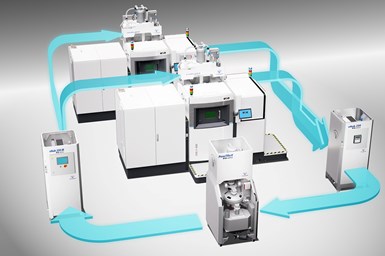EOS, Volkmann Collaborate on Automated Powder Transfer Solution
The Volkmann EOS Edition seamlessly integrates with EOS 3D printers.
3D printer manufacturer EOS and metal powder conveying equipment manufacturer Volkmann are partnering to integrate their technologies. As part of the global partnership, EOS will offer an EOS Edition line of Volkmann’s closed-loop and stand-alone, automated metal powder management systems which are specifically engineered for seamless, easy integration with the EOS M 400 series metal additive manufacturing (AM) systems.
The central metal powder management systems automatically control (1) the transfer and loading of material from storage into one or more 3D printers; (2) the capture and sieving of excess powder for reprocessing; and (3) the automated vacuum drying of metal powders. Buffer storage units and other accessories are also available with the new systems.
The systems are available in North America from both EOS North America and Volkmann USA. The EOS Edition may operate as a fully enclosed, sealed circuit to eliminate metallic dust from the workplace, safeguard workers from potential exposure, and protect the metal powders from ambient moisture and contamination. The scalable systems may be operated unattended, 24/7, and controlled and monitored remotely.
“Our new systems provide EOS end users with a complete, plug-and-play, automated powder handling solution that can scale as their production needs increase,” says Christian Mittman, director of advanced solutions for Volkmann. “This is a logical next step in our close relationship with EOS, and one that we feel will benefit EOS customers with faster, safer, more reliable printing and consistently high-quality printed parts.”
Related Content
-
How Avid Product Development Creates Efficiencies in High-Mix, Low-Volume Additive Manufacturing
Contract manufacturer Avid Product Development (a Lubrizol company) has developed strategies to streamline part production through 3D printing so its engineering team can focus on development, design, assembly and other services.
-
How AM Enables Cobot Automation for Thyssenkrupp Bilstein (Includes Video)
The shock absorber maker has responded to its staffing shortages through extensive use of collaborative robots. In-house 3D printing makes this possible by providing the related hardware needed to complete the cobot-automated cells.
-
Chuck Jaws Achieve 77% Weight Reduction Through 3D Printing
Alpha Precision Group (APG) has developed an innovative workholding design for faster spindle speeds through sinter-based additive manufacturing.












